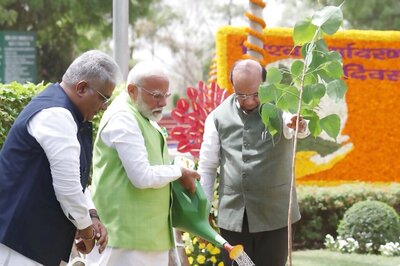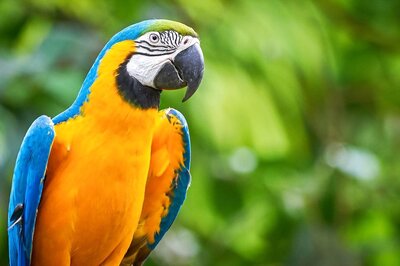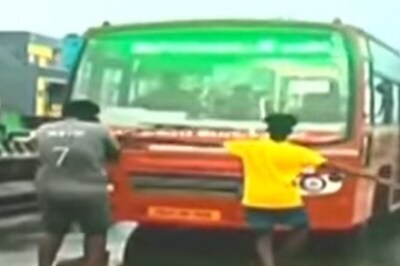
views
In Africa, off the coast of Kenya we spent weeks building wooden bridges for another species of primates. The Angolan Colobus monkey with its black and white coat is endangered, many of the animals get run over while crossing high-speed roads, which bifurcate the forests, they live in. So we built overhead bridges and ropeways across trees so that they no longer had to access the roads and fast speeding cars. Within weeks mortalities came down by ninety percent as the animals gamboled across the ropeways we had made.
Back in India I was building a shelter for monkeys. Even before the animal hospital was up an accident victim was brought in one morning. A three-month-old rhesus macaque infant clinging desperately to its mother's dead body. The rhesus mother had been mauled by a stray dog and had been brought in by people from a nearby village. The waif was not more than 1 kilo but she had the strength of an elephant. As we separated her from the mother's dead body, there was pain and fear in her eyes. She bit into my hand with all her might and shrieked. I had to get four anti-rabies injections. As I struggled with the pain of that bite (and the injections that followed!), it was heartening to note that a few days later the infant had adjusted with a foster mother an in house monkey, Basanti- had adopted her quite readily!
And then came the career switch. From conservation I traversed to the world of television. I started reporting on wildlife and environment issues for CNN-IBN. Unfortunately reporting on wildlife issues is considered as the softer side to journalism. My journalist colleague often teases me- so your next picnic is in which wildlife sanctuary? One of the first changes we made was the shift the 'wildlife' beat to the realm of special investigations. Across the country wildlife habitats are under siege. Wetlands are being drained and forests are being sold chunk by chunk. And all illegally in blatant violation of environmental laws.
One of the first assignments we took up in CNN-IBN was investigating why the lions of Gir were dying. The mighty Asiatic lions found only in the forests of Gujarat are dying a slow death, being poached for something as innocuous as their nails. ... In Orissa we spent five days on a boat recording dead turtles- some of India's biggest companies are drilling for oil, all along the migratory route used by the olive ridley turtles for mass-nesting. In Uttar Pradesh an airport was being built in complete violation of environmental laws- in the wetlands, which are home to nearly one third of the world's Sarus crane population. We arrived with our camera team and found an army of men shooing away the hapless birds so that the Supreme Court Committee (to assess if the airport would damage the habitat of the birds) had no evidence of the birds at the site of the airport.
Television they say is too shallow to take on such hard issues. In conservation you could spend an entire lifetime trying to save a wilderness area or an animal. The lifespan of a television story is two minutes and then you are on to the next story. But the medium hasn't been tapped fully. As forests shrink the need of the media as a watchdog will be even more. The time is ripe for a new era of reporting on the environment, which is hard-hitting and investigative. Sadly, the nature of the beat is such that the best stories are built on environmental tragedies and species going extinct. Quite like the reporter who goes out to report a bomb blast- this maybe his/her biggest story but its till a report on death and destruction. That's the irony of journalism.
About the AuthorBahar Dutt Bahar Dutt is a wildlife conservationist by training. She has worked for the last ten years on crucial wildlife conservation projects in India and abr...Read Morefirst published:September 18, 2006, 15:40 ISTlast updated:September 18, 2006, 15:40 IST
window._taboola = window._taboola || [];_taboola.push({mode: 'thumbnails-mid-article',container: 'taboola-mid-article-thumbnails',placement: 'Mid Article Thumbnails',target_type: 'mix'});
let eventFire = false;
window.addEventListener('scroll', () => {
if (window.taboolaInt && !eventFire) {
setTimeout(() => {
ga('send', 'event', 'Mid Article Thumbnails', 'PV');
ga('set', 'dimension22', "Taboola Yes");
}, 4000);
eventFire = true;
}
});
window._taboola = window._taboola || [];_taboola.push({mode: 'thumbnails-a', container: 'taboola-below-article-thumbnails', placement: 'Below Article Thumbnails', target_type: 'mix' });Latest News
My academic training was in the wildlife sciences. I was at Jersey Zoo off the coast of England set up by the famous author and wildlife conservationist Gerald Durrell. In the cold howling wind I sat huddled in a corner- my job was to record the behaviour of a family of five small furry monkeys roaming free in the Zoo- they were to be released back in Amazon forests and we were studying if they had acquired the skills to survive in the wild.
In Africa, off the coast of Kenya we spent weeks building wooden bridges for another species of primates. The Angolan Colobus monkey with its black and white coat is endangered, many of the animals get run over while crossing high-speed roads, which bifurcate the forests, they live in. So we built overhead bridges and ropeways across trees so that they no longer had to access the roads and fast speeding cars. Within weeks mortalities came down by ninety percent as the animals gamboled across the ropeways we had made.
Back in India I was building a shelter for monkeys. Even before the animal hospital was up an accident victim was brought in one morning. A three-month-old rhesus macaque infant clinging desperately to its mother's dead body. The rhesus mother had been mauled by a stray dog and had been brought in by people from a nearby village. The waif was not more than 1 kilo but she had the strength of an elephant. As we separated her from the mother's dead body, there was pain and fear in her eyes. She bit into my hand with all her might and shrieked. I had to get four anti-rabies injections. As I struggled with the pain of that bite (and the injections that followed!), it was heartening to note that a few days later the infant had adjusted with a foster mother an in house monkey, Basanti- had adopted her quite readily!
And then came the career switch. From conservation I traversed to the world of television. I started reporting on wildlife and environment issues for CNN-IBN. Unfortunately reporting on wildlife issues is considered as the softer side to journalism. My journalist colleague often teases me- so your next picnic is in which wildlife sanctuary? One of the first changes we made was the shift the 'wildlife' beat to the realm of special investigations. Across the country wildlife habitats are under siege. Wetlands are being drained and forests are being sold chunk by chunk. And all illegally in blatant violation of environmental laws.
One of the first assignments we took up in CNN-IBN was investigating why the lions of Gir were dying. The mighty Asiatic lions found only in the forests of Gujarat are dying a slow death, being poached for something as innocuous as their nails. ... In Orissa we spent five days on a boat recording dead turtles- some of India's biggest companies are drilling for oil, all along the migratory route used by the olive ridley turtles for mass-nesting. In Uttar Pradesh an airport was being built in complete violation of environmental laws- in the wetlands, which are home to nearly one third of the world's Sarus crane population. We arrived with our camera team and found an army of men shooing away the hapless birds so that the Supreme Court Committee (to assess if the airport would damage the habitat of the birds) had no evidence of the birds at the site of the airport.
Television they say is too shallow to take on such hard issues. In conservation you could spend an entire lifetime trying to save a wilderness area or an animal. The lifespan of a television story is two minutes and then you are on to the next story. But the medium hasn't been tapped fully. As forests shrink the need of the media as a watchdog will be even more. The time is ripe for a new era of reporting on the environment, which is hard-hitting and investigative. Sadly, the nature of the beat is such that the best stories are built on environmental tragedies and species going extinct. Quite like the reporter who goes out to report a bomb blast- this maybe his/her biggest story but its till a report on death and destruction. That's the irony of journalism.




















Comments
0 comment